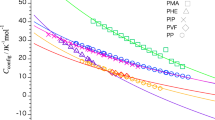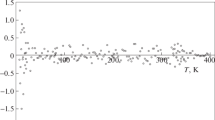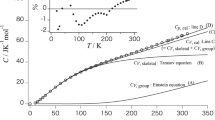Summary
The specific volume of pure and plasticized polyvinylchloride and of polymethylmethacrylate was studied with a dilatometer as function of temperature (−80 to +150 °C) and hydrostatic pressure (1 to 1000 at.). Beside the glass transition also two types of secondary transitions are observed with PVC and PMMA which correspond to dynamic secondary dispersion ranges.
Below the glass transition the specific volumina depend on how they were reached.
The transition temperatures of the samples were determined at elevated pressures with decreasing temperatures. Glass transition and secondary transitions cause stepwise increases of the thermal expansivities and the isothermal compressibilities. Above the glass transition the compressibilities are rising in proportion to the temperature.
With PVC all transition temperatures are shifted by about 0,013 to 0,015 °C/at as the pressure is raised. With PMMA the transitions at −7 °C and at +62 °C are not affected by hydrostatic pressure while the glass transition is shifted by 0,018 °C/at.
Addition of plasticizer to PVC shifts the glass transition to lower and the secondary transition to higher temperatures.
There is no agreement between the measured shifting factorsdT g/dp and those calculated according toEhrenfest's lawΔβ/Δα=dT g/dp.
Zusammenfassung
Das spezifische Volumen von reinem und weichgemachtem Polyvinylchlorid und von Polymethylmethacrylat wurde mit Hilfe eines Dilatometers als Funktion der Temperatur (−80 bis +150 °C) und des hydrostatischen Drucks (1 bis 1000 at) gemessen. Außer dem Glasübergang wurden bei PVC und PMMA noch weitere sekundäre Übergangsbereiche gefunden, die dynamischen Nebendispersionsgebieten entsprechen.
Unterhalb der Glastemperatur hängen die spezifischen Volumina stark von dem Wege ab, auf dem sie erreicht wurden.
Die Übergangstemperaturen der Proben wurden bei erhöhtem Druck mit fallender Temperatur bestimmt. Der Glasübergang und die sekundären Übergänge sind von stufenweisen Änderungen der thermischen Ausdehnungskoeffizienten und der isothermen Kompressibilitäten begleitet. Oberhalb des Glasübergangs steigen die Kompressibilitäten proportional zur Temperatur an.
Bei PVC werden alle Übergangstemperaturen durch steigenden Druck um etwa 0,013 bis 0,015 °C/at verschoben. Bei PMMA werden die Übergangsgebiete bei −7 °C und bei +62 °C durch hydrostatischen Druck nicht beeinflußt, während der Glasübergang um etwa 0,018 °C/at verschoben wird.
Der Zusatz von Weichmacher zu PVC verschiebt den Glasübergang zu tieferen und den sekundären Übergang zu höheren Temperaturen.
Die gemessenen VerschiebungsfaktorendT g/dp stimmen nicht mit den nach derEhrenfestschen Beziehung berechneten überein.
Similar content being viewed by others
References
Ferry, J. D., Viscoelastic Properties of Polymers, p. 220 (New York 1961).
Koppelmann, J. andJ. Gielessen, Z. Elektrochemie65, 689 (1961).
Morton, C., Trans. Far. Soc.33, 474 (1937).
Landolt-Börnstein, Zahlenwerte u. Funktionen, 6. Aufl., 4. Bd., 3. Teil, S. 21 (Berlin 1957).
Reitzel, J., J. Simon andJ. A. Walker, Rev. Sci. Instr.28, 828 (1957).
Landolt-Börnstein, Zahlenwerte u. Funktionen, 5. Aufl., HW I, 82; Eg I, 30, 678; Eg II, 1158; Eg IIIa, 70 (Berlin 1923).
Eiermann, K., K.-H. Hellwege undW. Knappe, Kolloid-Z.174, 134 (1961).
Dole, M., Kolloid-Z.165, 40 (1959).
Fox, T. G. andJ. Flory, J. Appl. Phys.21, 581 (1950).
Alfrey, T., G. Goldfinger andH. Mark, J. Appl. Phys.14, 700 (1943).
Heydemann, P. andA. Zosel, Acustica12, 360 (1962).
Heydemann, P. andH. Nägerl, to be published in Acustica14 (1964).
Koppelmann, J., Kolloid-Z.144, 12 (1955).
Mellan, I., The Behavior of Plasticizers, p. 16 (Oxford 1961).
Stuart, H. A., Die Physik der Hochpolymeren, Bd. IV, § 74 (Berlin-Göttingen-Heidelberg 1952–1956).
Illers, K. H., H. G. Kilian andR. Kosfeld, Ann. Rev. Phys. Chem.12, 49 (1961).
Wolf, K. A., Z. Elektrochemie65, 604 (1961).
Becker, G. W., Kolloid-Z.140, 1 (1955).
Nitsche, R. andK. A. Wolf, Kunststoffe, Bd. 1, S. 186 (Berlin 1962).
Koppelmann, J. andJ. Gielessen, Kolloid-Z.175, 97 (1961).
Hellwege, K. H., W. Knappe andP. Lehmann, Kolloid-Z. u. Z. Polymere183, 110 (1962).
Author information
Authors and Affiliations
Rights and permissions
About this article
Cite this article
Heydemann, P., Guicking, H.D. Specific volume of polymers as a function of temperature and pressure. Kolloid-Z.u.Z.Polymere 193, 16–25 (1963). https://doi.org/10.1007/BF01500062
Received:
Issue Date:
DOI: https://doi.org/10.1007/BF01500062




